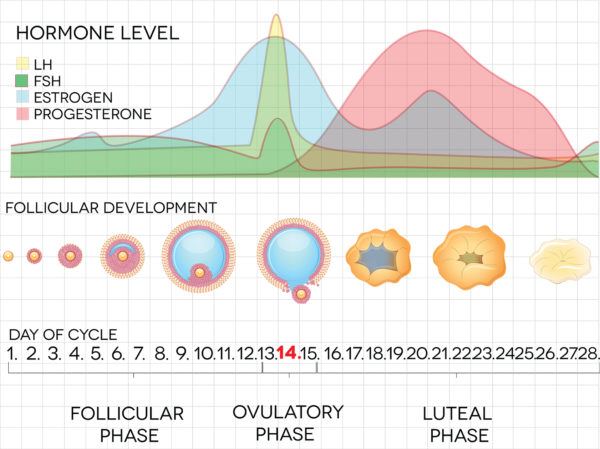Understanding your monthly cycle can help you learn how pregnancy happens

Knowing more about your monthly cycle and how hormones affect the release of an egg is important to learn for women wanting to get pregnant. During a woman’s monthly menstrual cycle, a complex interaction of different hormones wake up eggs, cause them to mature, ovulate, and prepare the uterus for pregnancy, or start all over again.
Not every woman experiences a monthly cycle that is a standard 28-days. Some women may have longer or shorter cycles and still be fertile. Other women may experience ovulation problems where they may go for months without a cycle.
How a typical monthly menstrual cycle functions
Here is how the monthly cycle for a healthy woman without ovulation problems should look like:
Day 1
The first day of your cycle is the first day of blood flow. Some women bleed for 3-6 days, others 2-3 days. It is not unusual to have some light spotting before the menstrual period.
Days 2-14
Early during this time period, follicle stimulating hormone, FSH, is the predominant hormone as your body sheds the endometrial lining then begins to thicken it up again in preparation for pregnancy. This is called the follicular phase. During this time, the endometrium starts to grow, the follicles on the ovary become active, and the cervical mucous begins to thin.
Day 14
Ovulation takes place midcycle. Rising estrogen levels trigger the release of leutenizing hormone, LH (the “LH” surge). The climbing level of LH causes the follicle to ovulate, releasing an egg. The timing of ovulation is not precise; it may occur between days 12 and 14, depending on the individual woman. That is why it is important to understand and chart your cycle (record your basal body temperature or your LH surge using an ovulation test kit). It is recommended that a woman have intercourse every other day around the time of ovulation to get pregnant, because sperm live for only about 48 hours.
Days 15-22
After releasing the egg, the follicle transforms into the corpus luteum, and progesterone is released, creating a lush uterine lining for implantation. This stage of the cycle is called the luteal phase.
Days 23 to 24
If there is no implantation, estrogen and progesterone levels fall.
Days 25 to 28
The falling progesterone levels trigger the shedding of the endometrium.
Deviations from a normal cycle can be indications of an underlying problem
Common signs of ovulation problems may be skipped or absent periods, or periods that come too often or too infrequently. Regular ovulation is crucial for a woman trying to get pregnant.
When a woman experiences no period at all consistently before the age of 40, primary ovarian insufficiency, or POI, may be suspected. When this happens, your ovaries don’t produce normal amounts of the hormone estrogen or release eggs regularly. Ultimately this process results in premature menopause where women stop having periods and cannot become pregnant.
Absent periods may also be a sign of low body mass index, or BMI, common in female athletes. Women who are involved in very heavy exercise typically have low body fat percentages which can often lead to ovulation problems. Athletes may need to resolve these issues before receiving specific treatment for infertility.
Polycystic ovary syndrome may be the cause for women with irregular menstrual cycles that are consistently less than 21 days apart or more than 35 days apart. Many women with PCOS don’t ovulate and thus cannot become pregnant. Luckily, drugs that can induce ovulation can help a woman with PCOS and irregular cycles get pregnant.
If you have questions about your menstrual cycle and whether it may be linked to your inability to conceive, contact our fertility specialists to learn more.


